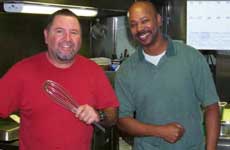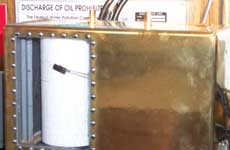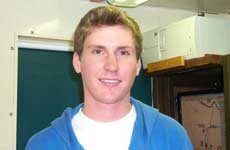


The Project
|
Daily JournalDecember 8, 2004: No place like home—
|
The New Horizon's cooks, |
Aside from sleeping, most people enjoy spending time eating. The ship has a dining area and a kitchen staffed by two cooks. Meals are served to coordinate with the times people may be getting off a shift or before they're starting one. On the New Horizon, breakfast is served from 7:15 - 8:00 a.m., Lunch from 11:15 - 12 noon, and dinner from 5:00 - 5:45. The cooks both needed prior marine cooking experience in order to get their jobs on the New Horizon. Edward Lograsso had cooked in restaurants since high school and had been a chef at three different restaurants on land. He also cooked for the tuna fleet for 10 years. To find his current job, he checked the UCSD website looking for marine cook positions. Mark Smith is the other cook. He began cooking at the age of 18 in the Navy. He has a total of 25 years cooking experience. Both Edward and Mark enjoy the opportunities to travel. Mark's favorite trips include visiting Capetown, South Africa, Australia, and Antarctica. Edward's most memorable trip was to Easter Island. Another reason they prefer to work on a ship is that co-workers become more like family than they do in jobs on land. In addition to preparing the food and cleaning the kitchen, Mark and Edward must also order enough food for the length of time the ship will be at sea. Some of the items that might be ordered for a 10 day cruise with about 30 people are: 2 cases of lettuce,5 cases of fresh fruit, 1 case of chicken, 30 pounds of filet mignon, and 20 pounds of fresh fish. They also order lots of flour because they bake their own bread.
While you are sleeping, eating, and working, the ship will be sailing from one point to another. The cost of sailing the R/V New Horizon is approximately $15,000 per day. Other NSF (National Science Foundation) sponsorships cost up to about $35,000 per day for the R/V Atlantis with the Alvin. The Alvin is a submersible lab that remains in contact with its mother ship the R/V Atlantis. Usually the R/V New Horizon stays near the coastline and departs and arrives at the Nimitz Marine Facility at Point Loma (San Diego). The R/V New Horizon has a cruising speed of 10 knots.
Math
A knotty question:
Knots measure the speed of aircraft and boats. Knots indicate a unit of distance traveled for a certain amount of time (just like miles per hour.)
1 knot = 1 nautical mile per hour = 6076 feet per hour
1 mph = 1 mile per hour = 5280 feet per hour
Question 4: Which is faster, one knot per hour or one mile per hour?
Question 5: Your speed boat is traveling at the equivalent of 65 miles per hour. How many knots per hour are you traveling?
To travel by car from one location to another, you need the mechanics of the car under the hood, plus the interior instruments on the dashboard, the steering wheel, and the accelerator and brake pedals on the floor. You also need someone to control the instruments. On a ship, the captain and other crew man the bridge, the place where directional, weather, and communication instruments are located. In the engine room, the crew monitor the output of the ship's engines and generators.
Top: Barograph |
The New Horizon's captain is John Manion. He has the primary responsibility for the ship. Although he may work in many areas of the ship, his primary workspace is called the bridge. Linda and Marian were given a tour of the bridge by Tony Morain, who has a 3rd mate's license. Tony attended a 4 year maritime college in California to receive his training. The bridge contains mostly modern instrumentation. An auto pilot feature is available. The radar screen shows the locations of other ships. An AIS system indicates how close other ships in the vicinity will pass. A radio is used to monitor 2 channels, one for the Coast Guard and the other for passing ships. However, there are a few pieces of equipment that would be familiar to persons who sailed the seas many years ago. Sound powered phones are used to communicate on board since they can be run without electricity. A simple barometer sat among all the modern pieces of equipment. Perhaps most notable is the absence of that long standing symbol of the sea, the ship's wheel. See the photo for the modern instrument that has taken its place.
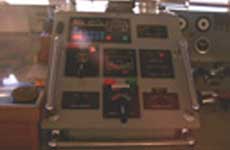
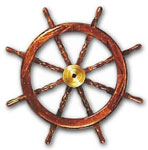
Above: the picture on the left is the ship's wheel.
Were you expecting to see something more like the picture on the right?
For the following questions, look in a dictionary or on the Internet.
Question 5: What does a barometer measure?
Question 6: When the barometer is dropping, what kind of weather can be expected?

The engine room
The New Horizon's chief engineer, |
The engine room is under the control of Steve St. Martin, the chief engineer. He will also assist the scientists if something breaks down. He began his career at sea in the Navy and worked his way up. These days, working your way up the career ladder is much more difficult, if not impossible to do, because of Coast Guard requirements. Steve has worked for Scripps for 28 years and has been working at sea for almost 35 years. His base is San Diego. If he needs to work in a different location, he will be flown there and back. For his next assignment, he will fly to Tahiti, sail to New Zealand, then fly back from there. One of the things he likes most about his job has been the opportunity to see places such as Easter Island and Antarctica. One of the drawbacks is that the job is hard on family life. Another drawback may be having to be around the same people all the time. He said that some people have described being on ship as "Being in jail with a chance of drowning."
Tomorrow: Life in the Lab at Sea
when all else fails...
![]()


